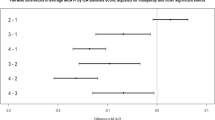Summary
In this study 11 patients aged between 34 and 57 years with clinical and angiographic findings typical of carotid dissection were thoroughly examined with transcranial Doppler ultrasound (TCD) repeatedly during a follow-up period of 1–6 months. Stagnating blood flow velocities in the downstream middle cerebral artery (MCA) were recorded initially as well as enhanced velocities due to postischaemic hyperperfusion syndrome. MCA embolism originating from the extracranial carotid artery with or without resolution could be detected by TCD in 5 cases. TCD findings in another 2 cases pointed to haemodynamic upset. In 3 cases, clinical as well as TCD data did not allow strict differentiation between embolic and haemodynamic complications, suggesting more complex pathophysiological mechanisms as the cause of infarction. Carotid recanalization was seen in 9 cases. The follow-up investigations moreover demonstrated that intracranial haemodynamics may change from day to day in patients suffering from internal carotid artery dissection. TCD data may thus improve the understanding of pathogenetics as well as rationales for individual therapeutic intervention in this particular disease.
Similar content being viewed by others
References
Aaslid R (1986) Transcranial Doppler Sonography. Springer, Vienna, New York
Aaslid R, Markwalder TM, Nornes H (1982) Noninvasive transcranial Doppler ultrasound recording of flow velocity in basal cerebral arteries. Neurosurgery 57:769–774
Arnolds BJ, Reutern GM von (1986) Transcranial Doppler sonography. Examination technique and normal reference values. Ultrasound Med Biol 12:115–123
Bogousslavsky J, Despland PA, Regli F (1987) Acute stroke due to spontaneous carotid artery dissection. Arch Neurol 44:137
Bradac GB, Kaernbach A, Bolk-Weischedel D, Finck GA (1981) Spontaneous dissecting aneurysm of cervical cerebral arteries. Neuroradiology 21:149–154
Chapleau CE, Robertson JT (1981) Spontaneous cervical carotid artery dissection: outpatient treatment with continuous heparin infusion using a totally implantable infusion device. Neurosurgery 8:83–87
Cusick JF, Daniels D (1981) Spontaneous reversal of internal carotid artery occlusion. Neurosurgery 54:811–813
Godon-Hardy S, Meder JF, Dilouya A, Monsaingeon V, Fredy D (1985) Ischemic strokes and oral contraception. Neuroradiology 27:588–592
Grotta JC (1987) Current status of hemodilution in acute cerebral ischaemia. Stroke 18:689–690
Halsey JH (1988) Prognosis of acute hemiplegia estimated by transcranial Doppler ultrasonography. Stroke 19:648–649
Hart RG, Easton DF (1983) Dissections of cervical and cerebral arteries. Neurol Clin North Am 1:155–182
Hart RG, Easton JD (1986) Dissections and trauma of cervicocerebral arteries. In: Barnett JM, Stein BM, Mohr JP, Yatsu FM (eds) Stroke: pathophysiology diagnosis and management. Churchill Livingstone, New York, pp 775–788
Hennerici M, Rautenberg W, Sitzer G, Schwarz A (1987) Transcranial Doppler ultrasound for the assessment of intracranial arterial flow velocity, 1. Surg Neurol 27:439–448
Lassen NA (1966) The luxury perfusion syndrome and its possible relation to acute metabolic acidosis localized in the brain. Lancet II:1113–1115
Mattle H, Grolimund P, Huber P, Sturzenegger M, Zurbrügg (1988) Transcranial Doppler sonographic findings in middle cerebral artery disease. Arch Neurol 45:289–295
McNeill DH, Dreisbach J, Marsden RJ (1980) Spontaneous dissection in the internal carotid artery. Its conservative management with heparin sodium. Arch Neurol 37:54–55
Nespeca MP, Townsend JJ (1987) Multiple cerebral emboli in a young man. West J Med 146:589–595
Olsen TS, Larson B, Skriver EB, Herning M, Enevoldsen E, Lassen NA (1981) Focal cerebral hyperemia in acute stroke: incidence, pathophysiology and clinical significance. Stroke 12:598–607
Rohr J, Gauthier G (1987) Hématomes disséquants spontanes successifs à 3 ans et demi d'intervalle des deux artères carotides internes. Rev Neurol 143:115–120
Shuster E, Mokri B, Sundt TM, Houser OW, Piepgras D (1985) Spontaneous dissection of the internal carotid arteries (ICA): outcome. Neurology 35 [Suppl 1]:212
Spencer MP, Whisler BS (1986) Transorbital Doppler diagnosis of intracranial arterial stenosis. Stroke 17:916–921
Torvik A (1984) The pathogenesis of watershed infarcts in the brain. Stroke 15:221–223
Author information
Authors and Affiliations
Rights and permissions
About this article
Cite this article
Kaps, M., Dorndorf, W., Damian, M.S. et al. Intracranial haemodynamics in patients with spontaneous carotid dissection. Eur Arch Psychiatr Neurol Sci 239, 246–256 (1990). https://doi.org/10.1007/BF01738579
Received:
Issue Date:
DOI: https://doi.org/10.1007/BF01738579




